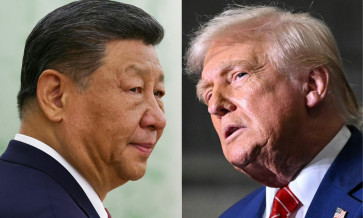Popular Reads
Top Results
Can't find what you're looking for?
View all search resultsPopular Reads
Top Results
Can't find what you're looking for?
View all search resultsANALYSIS: Using mobile money to increase financial inclusion in RI
With the rapid growth of the middle-income population and a better-educated demographic bonus, Indonesia is expected to experience a more sustainable economic growth
Change text size
Gift Premium Articles
to Anyone
W
ith the rapid growth of the middle-income population and a better-educated demographic bonus, Indonesia is expected to experience a more sustainable economic growth. One of the ways to achieve this is by increasing people's involvement in the financial sector, otherwise known as financial inclusion. As seen through comparative studies and from success stories in other countries, financial inclusion can be increased by optimizing the use of mobile money and banking.
Financial inclusion means that more people have access to the banking system, payment services, savings, investments or insurance. Inclusion could reap a great deal of benefit if it reaches the currently underserved group, namely the poor and vulnerable.
Because of Indonesia's widespread geography and its numerous islands, the biggest issue is how to reach the underserved group using the most cost-efficient and effective methods. Bank Indonesia (BI) and the Financial Services Authority (OJK) have come up with plans and regulations on how to increase financial inclusion through branchless banking schemes and the use of mobile money, so it could significantly cut operational and infrastructure costs.
Financial inclusion is not a problem specific to Indonesia. Of the world's 7 billion people, 6 billion have phone subscriptions and only 2 billion have bank accounts. Currently, Indonesia has about 200 million mobile telephone customers after 20 years of the industry being in existence, compared to 60 million banking customers after 350 years.
However, with the rising concern about financial deepening, the number of banking customers is also expected to increase in line with telecommunication-user growth. Hence, the use of mobile banking and electronic payment should be able to be make it possible to serve the poorer classes. Indonesia has high numbers of internet and mobile phone users, even among the poor and vulnerable. This is a potential resource for banks to tap, especially when there is an increasing interest in the convenience of e-commerce. However, several concerns need to be addressed.
Clearer mobile money regulations are needed. Mobile money is considered a new banking frontier in Indonesia and, therefore, it is still not thoroughly regulated. Bank Indonesia has issued a regulation (PBI No. 16/8/PBI/2014) on electronic money, but BI has not yet issued a circular letter (SE) on how it is to be implemented.
The regulatory side needs to set up clearer rules for security systems, risk management and personal data to ensure participants (stakeholders, industries and customers) so as to comply with the regulations. This will also prevent mobile money from being used for money laundering purposes.
Basic financial education is needed for mobile money users. New mobile cash users will experience reluctance because of security issues because of fears that it would be unsafe to keep money in cellular phones, to do transactions from mobiles or that the security of personal data would be breached by banks or telecom providers. However, habits will change as banks and telecom companies offer better products, interfaces or applications, as well as provide society with better education about mobile money. Consumer will also learn that using mobile cash is convenient, cost effective and that it saves time and transportation costs.
The turnover rate in mobile numbers must be lowered. Indonesia's mobile market is characterized with a high proportion of prepaid subscribers ' specifically 98 percent compared to 70 percent in the rest of the region. Prepaid numbers are easy to purchase, allowing consumers to change numbers or swap to other providers easily, to whichever gives them cheaper data and service plans. It is also common for Indonesians to have multiple cellular numbers. Mobile money may require change in this consumer behavior, as their cell numbers would act as their bank accounts.
Steadier telecom data providers are necessary. In Southeast Asia, Indonesia has the cheapest data package price in the region with a minimum of Rp 25,000 (US$2.13) per month. However, low cost has sacrificed the steadiness of telecom connections. While text messages (SMSs) cost Rp 250 to Rp 500 each and a banking transaction needs a minimum of two messages to complete, costs can increase if connections are unstable and consumers must repeatedly send or verify a transaction. If telecom providers are willing to invest more in data infrastructure, consumers will have better data connections. Also, as the number of mobile banking users grow, the cost of text messages will eventually get lower.
Simpler menus for non-smartphone users and more facilitation for smaller-sized transactions will help. New technology can be enabled as distribution points grow, along with trusted remote extensions belonging to banks, which means they will be able to offer more financial services tailored into suitable low-cost products. However, more user-friendly commands are required to execute transactions via SMS, especially because the poor still cannot afford smartphones. It is important for consumers to be able to execute smaller size payments so they can get used to cashless transactions.
Improving payment and cash networking is essential. The banking and finance industry should work closely with different types of non-banking points of service, so people can more easily deposit or withdraw money. Post offices, train stations, convenient store chains or banking agents should be able to partner up with banks. This reduces operational costs and creates new business models for partners as payment agents, transfer channels or remittance agents. In August, OJK started to seek feedback on its branchless banking regulations, which hopefully would accelerate financial inclusion through more efficient channels.
_________________________
The writer is a senior manager at the Mandiri Institute, an independent research think tank of Bank Mandiri, which focuses on public policy and the finance and banking sectors.










